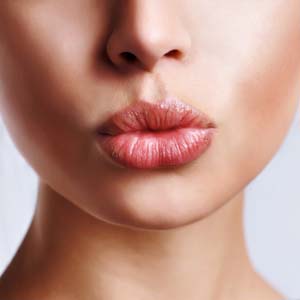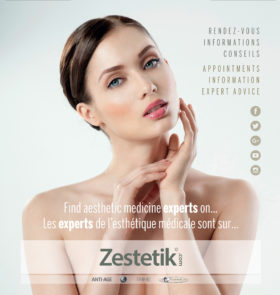By Doctor Thierry Boisaubert
Ptosis, vertical wrinkles, hollows, thinning lips and a retracted chin: the lower third of the face can greatly suffer from the effects of aging. But luckily, a wide variety of effective techniques are available to treat this area. The more the face has aged, the more likely a series of appointments will be required, spaced 3 to 4 weeks apart in order to ensure the fillers are properly integrated.
Step-by-step care
First of all, we need to correct the face’s “framework”; that means tightening up the oval of the face. This area requires clean, dynamic lines, so in order to avoid making it look heavy, we inject Radiesse superficially to restructure the lines and pull the tissue upwards without adding volume. We inject on either side of the jowls and up to the maxillary angle, in small quantities and massaging the gel after injection.
The chin requires particular attention, as it plays an important role in facial harmony and rejuvenation. It is important to bring it out into the light, as this is an area where shadows are dark and sizeable. If the chin has noticeably retracted (which is why it is useful to look at photos of the patient from 10 and 15 years earlier) or if it looks deflated, which has a great impact on facial aging, I use Belotero Volume. The gel is not very absorbent but very malleable, with great hold and optimum tissue integration. We are looking to achieve a plumped up, fleshy yet supple chin, which retains its mobility when the face is in movement. I have noticed that if we treat the chin first, the gel pulls the maxillary line up slightly, and therefore less product is needed to correct the oval of the face and the result is even more natural-looking. The face is looks both refined and illuminated.
Subtle correction of volumes
Once this job is done, I make an appointment to see the patient three weeks later in order to fill in any hollows while creating a subtle lift.
We need to plump up the mandibular indentations, correct any lines in the lips, smooth the nasolabial folds and redefine and plump up the mouth. In all of these areas I use Belotero Intense, which can be injected into the mid to deep dermal layers.
Mandibular indentations are treated using a needle and a small amount of product, which again is massaged in order to position it correctly. This type of hyaluronic acid is very elastic, hence why it is particularly suitable for the perioral zone. It is important to conserve the integrity and mobility of the area while erasing any expressions of bitterness and fatigue.
Next comes the mouth, whose contours I correct by injecting superficially into a series of points, then into the upper lip to give a bit more volume, but not too much. If necessary, a few drops of product are placed into the lower lip in order to create a “baby lips” effect. In general, one syringe is enough. Plump lips are very fashionable at the moment, and it is important to “resist” any pressure to overfill so as to avoid destroying the overall harmony of the work done, since an over-injected mouth, even only slightly, can quickly look “overdone”.
The upper lip and fine lines to finish
The last appointment is dedicated to erasing fine lines, including the unsightly upper lip “barcode”, which contributes to the overall rejuvenation and gives a “fresh” look. For a badly damaged upper lip, the blanching technique is ideal and requires very little product. However, it does require time and a careful hand. I inject droplets of Belotero Balance, superficially and into a series of points, for deep wrinkles and Belotero Soft for fine lines. The rest of the syringe is used to fill lines on the cheeks.
The secret lies in the finesse of the procedure. And, above all, in the time spent carrying out the treatment. You can do an awful lot with just a little product, providing you take your time and carefully examine the patient at regular intervals throughout the procedure.
Cosmetic medicine expert since 2000. Holder of an inter-university diploma in Morphological and Anti-Aging Medicine from the Aesthetic Faculty in Paris since 2007; course tutor; Director of the Esthélence centre for aesthetic medicine in Neuilly, France.








